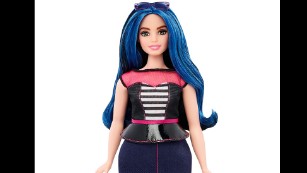Why it matters what Barbie looks like
(CNN)When did dolls become role models?
This question became the cynical undercurrent to news that Mattel unveiled new Barbie dolls
in three new body shapes -- petite, tall and curvy -- and seven skin
tones. The original Barbie is still for sale as well. While parents and
fans of the iconic blonde bombshell cheered the toymaker for making
dolls that look more like real people, others couldn't help rolling
their eyes at what they saw as a last-ditch effort by Mattel to regain
market share as Barbie loses ground to other dolls.
Actress
Kirstie Alley emerged as a voice from this camp, asking on Twitter if
the celebrations "seriously" implied that "Barbie needs to be taken
seriously." She stood her ground as people challenged her, reiterating
the point that she does not "consider toys to be role models."
"I
prefer humans," she said. "Apparently it is now politically incorrect
to make wisecracks about dolls now in America... hmmm and I thought they
were just toys."
She's
definitely not alone. Various news outlets fired off hot takes
questioning Barbie's influence with such headlines as "Barbie is Past
Saving" and "Did You Really Feel the Need to Identify With Your Barbie?"
Some argued that Mattel took too long to catch up to other doll makers
that have already made inclusiveness a selling point, and Barbie's
moment is over.
"Mattel
is, literally, messing with the mold that made Barbie iconic in the
first place. But that mold is more out of touch than ever. Most American
girls never looked like Barbie, it's true, but it's also true that most
American girls have never looked less like Barbie than they do right
now," Jessica Goldstein wrote for Think Progress.
"The
trouble with Barbie is that if you start taking away her unrealistic
elements, she disappears altogether," Alexandra Petri wrote in the Washington Post.
"Barbie
is either the iconic, unattainable figure, blonde and waiflike, with
huge eyes, or she is — what, exactly? Make her real, and she ceases to
exist. She becomes a brand, a category heading, like American Girl,
Monster High, Bratz."
Among
the critics, no one seems to be objecting to the idea of curvy Barbie, a
petite Barbie or an Asian Barbie with distinct features from "original
Barbie." It's more that, as VH1's Taylor Ferber put it, "I can't
honestly say that the plastic toy I played with was something I ever
wanted to look like in real life. Primarily because Barbies aren't real
life."
All of that is well and good, except that decades of research
show that children do absorb messages about body image and identity
from toys and play, though studies also show that different kids
identify in different ways and that countervailing influences can
minimize the impact.
As recently as 2006, a British study found
that "girls exposed to Barbie reported lower body esteem and greater
desire for a thinner body shape" than those who had been given dolls
reflecting larger body types or no dolls at all.
"What
people forget is all toys are educational to children, and girls learn
what it means to be a girl through the toys they have," said University
of Kentucky psychology professor Christia Spears Brown, author of
"Parenting Beyond Pink and Blue: How to Raise Kids Free of Gender."
"I don't think what Barbie looks like is a trivial issue," she said.
Mattel
has made changes in recent years to address criticism of Barbie's
unrealistic proportions and ethnocentric image. Mattel introduced Entrepreneur Barbie in 2014 and expanded the number of available skin tones, eye colors and hair styles available in June 2015.
Brown called the new line the "first legitimate change" by Mattel to make Barbie a more positive role model for children.
It's
more than simply putting a lab coat on the same busty, cinch-waisted
doll, or dipping her skinny body in a darker hue. Not only do they come
in different shapes and colors, but they have distinct features -- eyes,
hair, noses -- too.
"That's the message kids need to see, that people come in a range of sizes."
Now, if only the focus could shift away from her appearance, developmental psychologist Erica Weisgram said.
"One
of the things that's always concerning about the Barbie brand in
general is the focus on appearance," said Weisgram, who has examined the
impact of gender labels and gender-typed toys on children's toy
preferences..
There's nothing wrong
with being attractive, feminine or girly, she said. But girls should
know those aren't the only qualities to aspire to, Weisgram said.
"We
shouldn't look to dolls as role models," she said, "but we know that
when kids are playing, they are enacting social roles. They are playing
out what they might want to do in the future."
source: CNN






















